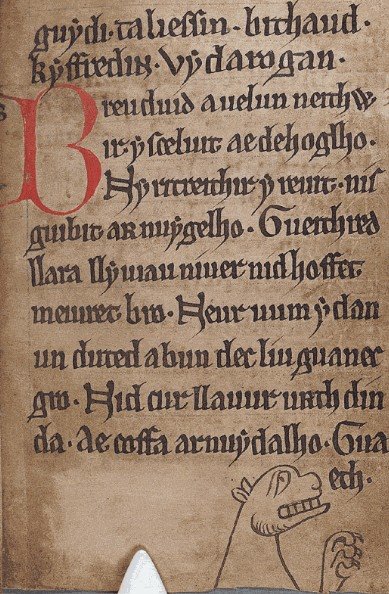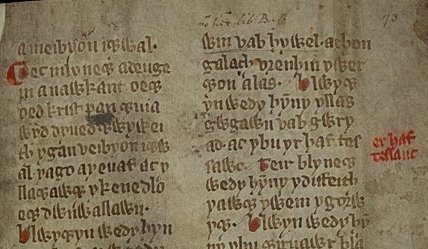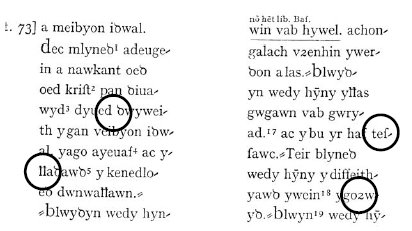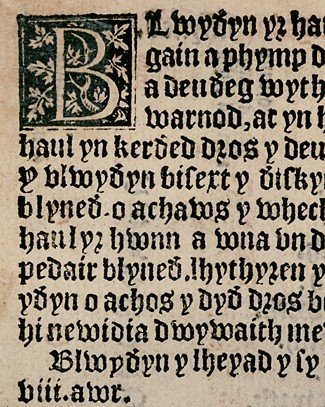BabelStone Blog
Sunday, 13 August 2006
Welsh Double D
I'm afraid that I'm still obsessing with the finer points of medieval orthography, and so over the next couple of weeks I'm going to discuss a couple of Welsh oddities that I have come across recently.
As everyone knows, Welsh "dd" is pronounced /ð/, but what may not be so well known is that it was not always written this way. In medieval Welsh manuscripts, words which in modern Welsh are spelled with double d are almost always spelled with a single "d" (or sometimes "t"). Thus early Welsh texts do not differentiate modern Welsh /d/ and /ð/, presumably because /ð/ is a later phonetic development. The following example is from one of the earliest Welsh manuscripts, written during the late 13th century :
The Black Book of Carmarthen (NLW MS Peniarth 1 folio 4r)

The start of the prophetic poem Breuddwyd a Welwn Neithiwr "The dream I saw last night", written Breuduid a uelun neithir.
As far as I can tell, up until the 15th century the /ð/ sound is not normally represented in written Welsh. However, there is one manuscript that does distinguish /ð/ from /d/ in some parts, that is MS Peniarth 20 (mostly comprising the text of Brut y Tywysogion "The Chronicle of the Princes"), which was written about 1330.
In the latter section of Brut y Tywysogion /ð/ is not differentiated, but in the earlier parts /d/ and /ð/ do seem to be distinguished, as can be seen from the words blwydyn wedy (modern Welsh blwyddyn wedi "the next year") shown below. In the example from page 264 modern Welsh "d" and "dd" both correspond to an ordinary letter "d", whereas in the example from page 73 modern Welsh "d" corresponds to an ordinary letter "d" but modern Welsh "dd" corresponds to what appears to be the common Latin abbreviation for "que", that is the letter "q" followed by the "3" shaped letter "et" (which is proposed for encoding in N3027). I'm not entirely sure whether this is a novel reuse of the Latin abbreviation for "que" or whether there is some other explanation for this peculiar letter, but as I have been unable to find any other examples of it in other Welsh manuscripts, it may be an idiosyncrasy of the particular scribe who wrote this section of Brut y Tywysogion. Whatever the origin of the letter, I think that it must be one of the earliest indications of the phonetic shift of /d/ to /ð/.
| Peniarth MS 20 p.73 | Peniarth MS 20 p.264 |
|---|---|
 |
 |
| /d/ and /ð/ differentiated | /d/ and /ð/ not differentiated |
The following is a short extract from MS Peniarth 20 that shows the use of this letter, followed by the corresponding transcription in Thomas Jones's 1941 scholarly edition of Brut y Tywysogyon (taken from N3027 Fig.1). What seems particularly perverse to me is that Jones transcribes this letter with an "insular" letter d, but transcribes what in the manuscript is an "insular" letter d as an ordinary "d".
The Chronicle of the Princes (NLW MS Peniarth 20 page 73)


Despite this one manuscript, it was not until the late 15th century that /ð/ came to be regularly represented in written Welsh. During the 15th and 16th centuries it is variously represented by "dd", "dh" or (in blackletter) d with a dot above. In early printed texts, d with a dot above seems most common in blackletter type and "dh" in roman type. However, when representing a /ð/ sound blackletter capital "D" is always followed by an "h" even when lowercase d is dotted (see second example below).
Yny lhyvyr hwnn (London, 1546) page 22

This book uses d with dot above, e.g. Blwydyn (blwyddyn "year") on lines 1, 6 and 12.
Y Drych Cristianogawl (1585) page xii

This book uses "Dh" and dotted d, e.g. Dhyd (Ddydd "Day"), Dhuw (Dduw "God"), drwg (ddrwg "evil"), digon (ddigon "enough").
When the Welsh Bible was published in 1588 it used "dd" for /ð/, and due to its overwhelming influence as the standard for written Welsh, "dd" has been used for this sound ever since.
Index of BabelStone Blog Posts